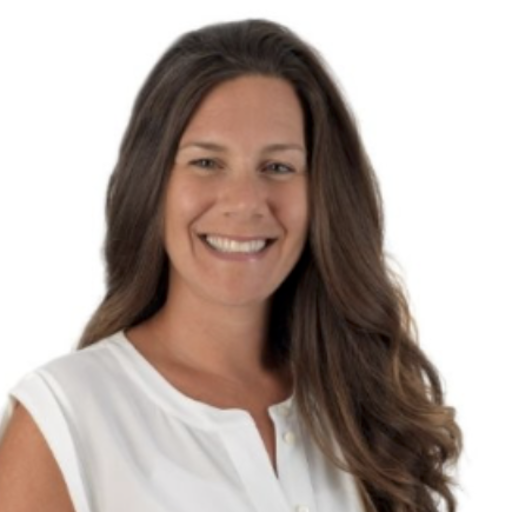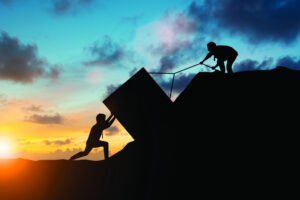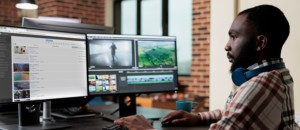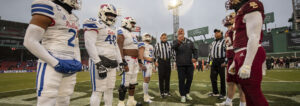WASABI
Music & Cloud Storage Pioneer: 10 Burning Questions with David Friend
Music & Cloud Storage Pioneer: 10 Burning Questions with David Friend
David Friend may singlehandedly be the most interesting person I’ve ever met.
From his storied background in the music industry to being a wildly successful CEO with six successful startups under his belt, there is always something new and different to learn from him and about him. During one of our recent meetings, I told him many people have a similar opinion about him, and he just giggled. He said he never thought of himself that way and was just interested in getting to know others. Another thing about Dave: He’s super humble and a great listener.
As a philanthropist, one of Dave’s greatest passions is supporting young talent in the arts. In fact, the recital hall at Berklee College of Music is named the David Friend Hall. With that in mind, it was only fitting that music would be at the forefront of our corporate partnerships and community programs. Through Wasabi’s partnership with the Fenway Sports Group, we are the presenting sponsor of the Plainridge Park Casino Fenway Concert Series and a founding partner of the MGM Music Hall, the latter of which will be used to showcase local talent and support the arts here in Boston.
Many people aren’t truly familiar with David’s involvement with the arts, other than hearing passing comments like, “Did you know that Dave has a Grammy?” or “David helped create the first synthesizer.” So rather than keep these fantastic stories in Wasabi folklore, we felt it was important to share the true stories behind the most interesting person in the tech industry. Here are the answers to some of the burning questions I’ve had since getting to know David Friend.
Question 1: At what point in your life did you get into music? Have you always been musically inclined?
David Friend: My mom was a serious amateur musician, so I grew up with a lot of live chamber music in the house, plus a pretty extensive record collection ranging from Bach organ music to big band jazz. I started piano lessons at age 4. I fell in love with a cappella vocal music in high school and pursued that through my years at Yale, where I double-majored in music and electrical engineering. I built the Yale electronic music studio as a bursary job and co-founded ARP instruments after grad school. We set up the world’s first teaching lab for synthesizer performance at the Berklee College of Music in the early 70s, and I sat on Berklee’s Board of Trustees for 25 years. There’s a David Friend Recital Hall at Berklee.
Question 2: How did ARP instruments come about? What was the impetus for developing it?
DF: I was still in grad school at Princeton when I got a call from a lawyer in Boston who said he had a client who wanted to start a synthesizer company. I promptly dropped out and moved to Boston to co-found ARP.
Forty years ago, synthesizers were big, expensive, and very complicated. They were used primarily in universities and some recording studios. But the synthesizer sounds were starting to show up in popular music. I figured that if we could make simpler, cheaper, and smaller synthesizers, we could sell them to high school rock bands through music stores.
My business, ARP Instruments, produced synthesizers ultimately used by Stevie Wonder, The Who, David Bowie, Led Zeppelin, and hundreds of other big-name artists. An ARP even helped Steven Spielberg communicate with aliens providing the legendary five-note communication in “Close Encounters of the Third Kind.”
Question 3: What was it like partnering with Steven Spielberg to develop the first five notes to Close Encounters of the Third Kind?
DF: That tune came from the composer John Williams, who also did the soundtracks for Star Wars, Back to the Future, and dozens of other films. We worked with Spielberg’s team to customize the synthesizer that appeared in the movie and to create the sounds themselves.
Question 4: How did you transition from music to cloud technology?
DF: I have undergraduate degrees in music and electrical engineering. Starting a synthesizer company was the obvious next step. While running ARP, the synthesizer company, I got into software. My next companies were all software businesses. Finally, in the mid-90s, backing up computers over the Internet became possible, and my previous company, Carbonite, became a pioneer in that business by storing backups in the cloud. I observed that there were many more uses for storing data in the cloud beyond backups. So when we started Wasabi, we decided to be a low-cost, high-performing cloud storage solution that could be used for backups, surveillance, genomics, medical imaging, scientific research, financial data, and thousands of other needs.
Question 5: What lessons from your musical years have you applied in your role as CEO of Wasabi?
DF: When I started in the synthesizer business in 1970, synthesizers were big, complicated, expensive machines that we sold directly to end customers, mostly university electronic music studios. I figured if we could make them simple and inexpensive enough, high school rock bands would buy them. But that meant building a network of dealers, i.e., retail music stores. So distribution was vital.
This experience taught me the importance (and difficulty) of making something simple and the importance of distribution as a way to reach the customer. Distribution and simplicity are tied together. For a product to be successful through distribution, it must be simple because otherwise, the distributor’s salespeople will never learn how to sell your product.
Question 6: What can you tell us about your involvement with Berklee and up and supporting up-and-coming artists?
DF: While I was thinking about how to make simple synthesizers, Berklee College of Music approached me about setting up a teaching lab for students who wanted to learn about synthesizers. It was the first of its kind in the world, and over the years, thousands of students have passed through the Music Technology program that I helped start back in the 1970s. I absolutely love the energy and creativity at Berklee.
Question 7: Wasabi has been involved with several music-related community initiatives, partnerships (Fenway Concert Series, Red Hot Beats), and now the MGM Music Hall. How important is it to you to remain engaged in the musical community?
DF: Music, like engineering and programming, is a creative endeavor. Most musicians these days are very knowledgeable about technology and use it significantly in their music. Likewise, any company that employs many engineers and programmers is likely to have several company bands. Wasabi’s continued involvement with music exposes us to an audience likely to be heavy on tech-savvy listeners. It also communicates to employees that the creative arts matter to the company.
Question 8: If you had to pick one classic song to describe Wasabi today, what would it be?
DF: Hmmm…
Question 9: Who was your favorite artist over the years, and why?
DF: The 1970s, in particular, was a decade of significant changes in music, spurred in part by the cultural upheavals. So many artists were breaking new ground, and technology was giving artists the ability to create entirely new sounds. But good music endures, and people today still listen to The Who, Stevie Wonder, Led Zeppelin, Jimi Hendrix, and many others who defined the sound of popular music for decades that followed.
Question 10: ARP custom-built a pressure-sensitive keyboard for Stevie Wonder in the 70s. What was the process of putting that design together and bringing it to life?
DF: Stevie Wonder is a brilliant artist who constantly pushed the boundaries of what his instruments could do. Working with him was fun because he is a quick learner and full of new ideas. He was, and probably still is, always one step ahead of what instruments can do. The idea of a pressure-sensitive keyboard was a significant technical challenge back then, but now it is a commonplace. Again, he was looking for what didn’t exist but might be possible.
the bucket
David Friend may singlehandedly be the most interesting person I’ve ever met.
From his storied background in the music industry to being a wildly successful CEO with six successful startups under his belt, there is always something new and different to learn from him and about him. During one of our recent meetings, I told him many people have a similar opinion about him, and he just giggled. He said he never thought of himself that way and was just interested in getting to know others. Another thing about Dave: He’s super humble and a great listener.
As a philanthropist, one of Dave’s greatest passions is supporting young talent in the arts. In fact, the recital hall at Berklee College of Music is named the David Friend Hall. With that in mind, it was only fitting that music would be at the forefront of our corporate partnerships and community programs. Through Wasabi’s partnership with the Fenway Sports Group, we are the presenting sponsor of the Plainridge Park Casino Fenway Concert Series and a founding partner of the MGM Music Hall, the latter of which will be used to showcase local talent and support the arts here in Boston.
Many people aren’t truly familiar with David’s involvement with the arts, other than hearing passing comments like, “Did you know that Dave has a Grammy?” or “David helped create the first synthesizer.” So rather than keep these fantastic stories in Wasabi folklore, we felt it was important to share the true stories behind the most interesting person in the tech industry. Here are the answers to some of the burning questions I’ve had since getting to know David Friend.
Question 1: At what point in your life did you get into music? Have you always been musically inclined?
David Friend: My mom was a serious amateur musician, so I grew up with a lot of live chamber music in the house, plus a pretty extensive record collection ranging from Bach organ music to big band jazz. I started piano lessons at age 4. I fell in love with a cappella vocal music in high school and pursued that through my years at Yale, where I double-majored in music and electrical engineering. I built the Yale electronic music studio as a bursary job and co-founded ARP instruments after grad school. We set up the world’s first teaching lab for synthesizer performance at the Berklee College of Music in the early 70s, and I sat on Berklee’s Board of Trustees for 25 years. There’s a David Friend Recital Hall at Berklee.
Question 2: How did ARP instruments come about? What was the impetus for developing it?
DF: I was still in grad school at Princeton when I got a call from a lawyer in Boston who said he had a client who wanted to start a synthesizer company. I promptly dropped out and moved to Boston to co-found ARP.
Forty years ago, synthesizers were big, expensive, and very complicated. They were used primarily in universities and some recording studios. But the synthesizer sounds were starting to show up in popular music. I figured that if we could make simpler, cheaper, and smaller synthesizers, we could sell them to high school rock bands through music stores.
My business, ARP Instruments, produced synthesizers ultimately used by Stevie Wonder, The Who, David Bowie, Led Zeppelin, and hundreds of other big-name artists. An ARP even helped Steven Spielberg communicate with aliens providing the legendary five-note communication in “Close Encounters of the Third Kind.”
Question 3: What was it like partnering with Steven Spielberg to develop the first five notes to Close Encounters of the Third Kind?
DF: That tune came from the composer John Williams, who also did the soundtracks for Star Wars, Back to the Future, and dozens of other films. We worked with Spielberg’s team to customize the synthesizer that appeared in the movie and to create the sounds themselves.
Question 4: How did you transition from music to cloud technology?
DF: I have undergraduate degrees in music and electrical engineering. Starting a synthesizer company was the obvious next step. While running ARP, the synthesizer company, I got into software. My next companies were all software businesses. Finally, in the mid-90s, backing up computers over the Internet became possible, and my previous company, Carbonite, became a pioneer in that business by storing backups in the cloud. I observed that there were many more uses for storing data in the cloud beyond backups. So when we started Wasabi, we decided to be a low-cost, high-performing cloud storage solution that could be used for backups, surveillance, genomics, medical imaging, scientific research, financial data, and thousands of other needs.
Question 5: What lessons from your musical years have you applied in your role as CEO of Wasabi?
DF: When I started in the synthesizer business in 1970, synthesizers were big, complicated, expensive machines that we sold directly to end customers, mostly university electronic music studios. I figured if we could make them simple and inexpensive enough, high school rock bands would buy them. But that meant building a network of dealers, i.e., retail music stores. So distribution was vital.
This experience taught me the importance (and difficulty) of making something simple and the importance of distribution as a way to reach the customer. Distribution and simplicity are tied together. For a product to be successful through distribution, it must be simple because otherwise, the distributor’s salespeople will never learn how to sell your product.
Question 6: What can you tell us about your involvement with Berklee and up and supporting up-and-coming artists?
DF: While I was thinking about how to make simple synthesizers, Berklee College of Music approached me about setting up a teaching lab for students who wanted to learn about synthesizers. It was the first of its kind in the world, and over the years, thousands of students have passed through the Music Technology program that I helped start back in the 1970s. I absolutely love the energy and creativity at Berklee.
Question 7: Wasabi has been involved with several music-related community initiatives, partnerships (Fenway Concert Series, Red Hot Beats), and now the MGM Music Hall. How important is it to you to remain engaged in the musical community?
DF: Music, like engineering and programming, is a creative endeavor. Most musicians these days are very knowledgeable about technology and use it significantly in their music. Likewise, any company that employs many engineers and programmers is likely to have several company bands. Wasabi’s continued involvement with music exposes us to an audience likely to be heavy on tech-savvy listeners. It also communicates to employees that the creative arts matter to the company.
Question 8: If you had to pick one classic song to describe Wasabi today, what would it be?
DF: Hmmm…
Question 9: Who was your favorite artist over the years, and why?
DF: The 1970s, in particular, was a decade of significant changes in music, spurred in part by the cultural upheavals. So many artists were breaking new ground, and technology was giving artists the ability to create entirely new sounds. But good music endures, and people today still listen to The Who, Stevie Wonder, Led Zeppelin, Jimi Hendrix, and many others who defined the sound of popular music for decades that followed.
Question 10: ARP custom-built a pressure-sensitive keyboard for Stevie Wonder in the 70s. What was the process of putting that design together and bringing it to life?
DF: Stevie Wonder is a brilliant artist who constantly pushed the boundaries of what his instruments could do. Working with him was fun because he is a quick learner and full of new ideas. He was, and probably still is, always one step ahead of what instruments can do. The idea of a pressure-sensitive keyboard was a significant technical challenge back then, but now it is a commonplace. Again, he was looking for what didn’t exist but might be possible.
featured articles
WASABI MEDIA & ENTERTAINMENT
April 10, 2024
Introducing Wasabi AiR: Unleash the Power of AI wit...
Introducing Wasabi AiR: Unleash the Power of AI wi...
TECHNOLOGY
April 23, 2024
Responsible AI Use: Lessons from an Industry Inside...
Responsible AI Use: Lessons from an Industry Insid...
TECH PARTNERS HEALTHCARE
April 18, 2024
Protect Your Research Data with Cost-friendly, Powe...
Protect Your Research Data with Cost-friendly, Pow...
TECH PARTNERS
April 11, 2024
Addressing AI Infrastructure Challenges with Wasabi...
Addressing AI Infrastructure Challenges with Wasab...
VIDEO SURVEILLANCE
April 9, 2024





